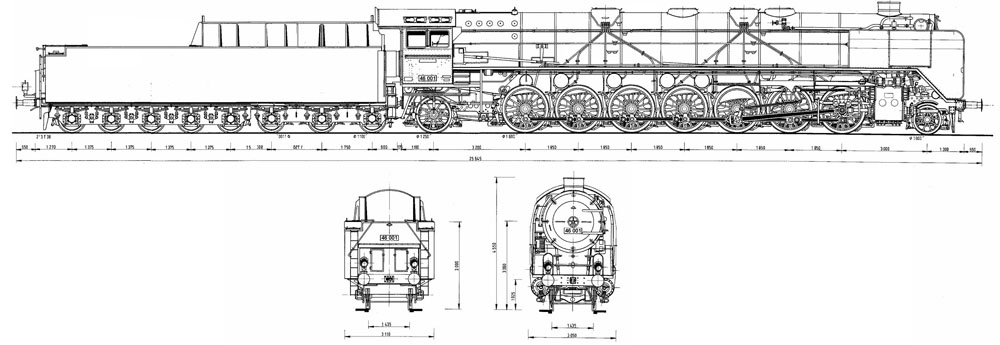



Country
Year
Class
Superheated steam 3 cylinder simple exp.
2-14-2

Having heard that Stalin had built a locomotive with 7 coupled axles, Hitler did not want to be outdone and ordered the construction of such a locomotive. It was to be used to pull the convoys on the Berlin-Moscow route, which Hitler considered already conquered.
To those who told him (at the risk of their lives) that such a locomotive would not be able to negotiate the slightest curve, Hitler replied that between Berlin and Moscow there was no need for curves: it was enough to build a nice straight line with sufficiently large turntables at the end.
It is well known that dictators are not very familiar with mechanics, but they have a remarkable capacity for conviction.
The technicians of the Lokomotive Bauanstalt in collaboration with the Reichbahnanstalt zur Entwicklung Unwarscheinlicher Dampflokomotiven decided to modify the successful design of the beautiful Br 45 and you can see the result here.
The locomotive was set up in the Henschel workshops, but very few resources were allocated to its production. After three years, in the spring of 1945, the Americans who occupied Kassel found only a couple of steel bars riveted with seven grooves and did not even bother to ask what they were for.
The information I am giving you comes from Otto Sieben, who was the only person at the time who worked on the project. He was later interned in a gulag in Siberia, from which he came out in 1948 to deal with the planning of mango cultivation in the now defunct German Democratic Republic.
Otto is now retired and has only one regret: not being able to know whether the Br 46 would have been able to leave the construction workshop without derailing...
To those who told him (at the risk of their lives) that such a locomotive would not be able to negotiate the slightest curve, Hitler replied that between Berlin and Moscow there was no need for curves: it was enough to build a nice straight line with sufficiently large turntables at the end.
It is well known that dictators are not very familiar with mechanics, but they have a remarkable capacity for conviction.
The technicians of the Lokomotive Bauanstalt in collaboration with the Reichbahnanstalt zur Entwicklung Unwarscheinlicher Dampflokomotiven decided to modify the successful design of the beautiful Br 45 and you can see the result here.
The locomotive was set up in the Henschel workshops, but very few resources were allocated to its production. After three years, in the spring of 1945, the Americans who occupied Kassel found only a couple of steel bars riveted with seven grooves and did not even bother to ask what they were for.
The information I am giving you comes from Otto Sieben, who was the only person at the time who worked on the project. He was later interned in a gulag in Siberia, from which he came out in 1948 to deal with the planning of mango cultivation in the now defunct German Democratic Republic.
Otto is now retired and has only one regret: not being able to know whether the Br 46 would have been able to leave the construction workshop without derailing...
